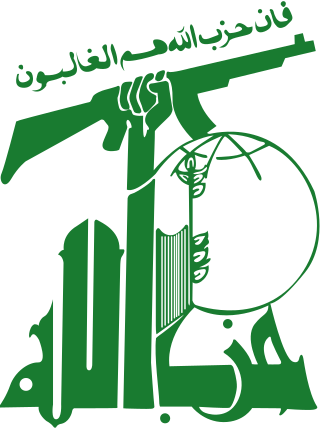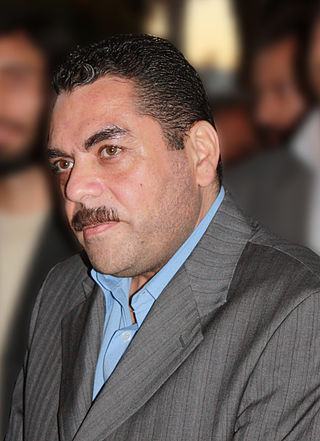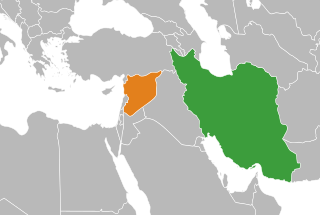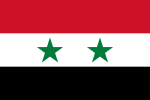
Hezbollah is a Lebanese Shia Islamist political party and militant group, led since 1992 by its Secretary-General Hassan Nasrallah. Hezbollah's paramilitary wing is the Jihad Council, and its political wing is the Loyalty to the Resistance Bloc party in the Lebanese Parliament. Its armed strength is assessed to be equivalent to that of a medium-sized army.

The Shebaa Farms, also spelled Sheba'a Farms, also known as Mount Dov, is a small strip of land at the intersection of the Lebanese–Syrian border and the Israeli-occupied Golan Heights. The territory is named for the farms within it which were historically tended by the inhabitants of the Lebanese town of Shebaa. It is about 11 kilometres (7 mi) long and 2.5 kilometres (2 mi) wide.

Beginning in the mid 2000s, the military and diplomatic corps of the Russian Federation has had various contacts and relations with entities on both sides of the Iran–Israel proxy conflict. This is a component of Russia's broader foreign policy across the entire Middle East region.
Foreign involvement in the 2006 Lebanon War refers to the supply of military aid to combatants during the course of the 2006 Lebanon War, which has been an important aspect of both the hostilities and the diplomatic wrangling surrounding them, including figuring prominently into UN Security Council resolutions on the topic.

Ghajar, also Rhadjar, is an Alawite-Arab village on the Hasbani River, on the border between Lebanon and the Israeli-occupied portion of the Golan Heights. In 2022, it had a population of 2,806.

Samir Kuntar was a Lebanese Druze member of the Palestine Liberation Front and Hezbollah. He was convicted of terrorism and murder by an Israeli court. After his release from prison as part of the 2008 Israel–Hezbollah prisoner exchange, he received Syria's highest medal, was honored by Iranian President Mahmoud Ahmadinejad, and was designated a Specially Designated Global Terrorist by the US government.

Syria and Iran are strategic allies. Syria is usually called Iran's "closest ally", notwithstanding the conflict between the Arab nationalism ideology of Syria's secular ruling Ba'ath Party and the Islamic Republic of Iran's pan-Islamist policy. Iran and Syria have had a strategic alliance ever since the Iran–Iraq War, when Syria sided with non-Arab Iran against neighbouring Ba'ath-ruled Iraq. The two countries shared a common animosity towards then-Iraqi president Saddam Hussein and coordination against the United States and Israel.
The 2012–2014 Quneitra Governorate clashes began in early November 2012, when the Syrian Army began engaging with rebels in several towns and villages of the Quneitra Governorate. The clashes quickly intensified and spilled into the UN-supervised neutral demilitarized zone between Syrian controlled territory and the Israeli-occupied Golan Heights.

The Iran–Israel proxy conflict, also known as the Iran–Israel proxy war or Iran–Israel Cold War, is an ongoing proxy conflict between Iran and Israel. In the Israeli–Lebanese conflict, Iran has supported Lebanese Shia militias, most notably Hezbollah. In the Israeli-Palestinian conflict, Iran has backed Palestinian groups such as Hamas. Israel has supported Iranian rebels, such as the People's Mujahedin of Iran, conducted airstrikes against Iranian allies in Syria and assassinated Iranian nuclear scientists. In 2018 Israeli forces directly attacked Iranian forces in Syria.

Following the outbreak of the protests of Syrian revolution during the Arab Spring in 2011 and the escalation of the ensuing conflict into a full-scale civil war by mid-2012, the Syrian Civil War became a theatre of proxy warfare between various regional powers such as Turkey and Iran. Spillover of the Syrian civil war into the wider region began when the Iraqi insurgent group known as the Islamic State of Iraq (ISI) started intervening in the conflict from 2012.

Several incidents have taken place on the Israeli–Syrian ceasefire line during the Syrian Civil War, straining the relations between the countries. The incidents are considered a spillover of the Quneitra Governorate clashes since 2012 and later incidents between Syrian Army and the rebels, ongoing on the Syrian-controlled side of the Golan and the Golan Neutral Zone and the Hezbollah involvement in the Syrian Civil War. Through the incidents, which began in late 2012, as of mid-2014, one Israeli civilian was killed and at least 4 soldiers wounded; on the Syrian-controlled side, it is estimated that at least ten soldiers were killed, as well as two unidentified militants, who were identified near Ein Zivan on Golan Heights.
The January 2015 Mazraat Amal incident was an airstrike against a two-car convoy that killed six Hezbollah fighters, including two prominent commanders, and a general of the Iranian Revolutionary Guards (IRGC), Mohammad Ali Allahdadi, at al-Amal Farms in the Quneitra District of Syria, in the Eastern Golan Heights, on 18 January 2015, during the Syrian Civil War. The attack was largely attributed to Israel, which did not officially confirm that it carried it out. Hezbollah and IRGC held Israel responsible and threatened to retaliate. On 19 January 2015, Al-Nusra Front member Abu Azzam al-Idlibi claimed that Jihad Mughniyeh and the other Hezbollah fighters were killed in an Al-Nusra Front ambush at Jaroud in the Qalamoun Mountains in the Al-Qutayfah District northeast of Damascus, claiming that it "will be the end of the Persian project, God willing."

As a response to an Israeli attack against a military convoy comprising Hezbollah and Iranian officers on January 18, 2015 at Quneitra in southern Syria, the Lebanese Hezbollah group launched an ambush on January 28 against an Israeli military convoy in the Israeli-occupied Shebaa Farms, firing anti-tank missiles against two Israeli Humvees patrolling the border, destroying the two Humvees and killing 2 and wounding 7 Israeli soldiers, according to Israeli military. The number of Israeli casualties was 15 according to a report by Al Mayadeen television station. A Spanish UN peacekeeper was also killed by Israeli fire during consequent fire exchanges in the area, with Israel firing artillery and Hezbollah responding by mortar shells. The conflict ended later the same day after UNIFIL mediation.
Israel's official position on the Syrian Civil War has been strict neutrality. However, Israel has become involved politically and militarily to prevent the growing influence and entrenchment of Iranian forces and its proxies throughout Syria. Israel's military activity, officially called Operation Chess, has primarily been limited to missile and air strikes targeting Iranian facilities in Syria as well as those of its proxies, especially Hezbollah. These attacks were not officially acknowledged before 2017. Israel has also carried out air strikes in Syria to disrupt weapons shipments to Hezbollah. By August 2022, the UK investigative non-profit Airwars estimated that 17-45 civilians were killed and another 42-101 civilians were wounded by Israeli airstrikes in Syria since 2013. Syrian reports place these figures much lower than other foreign actors in the conflict. Israel has also provided humanitarian aid to victims of the civil war from 2013 to September 2018, an effort that was ramped up after June 2016 with the launch of Operation Good Neighbour.

Hezbollah involvement in the Syrian Civil War has been substantial since the beginning of armed insurgency phase of the Syrian Civil War in 2011, and evolved into active support for Ba'athist government forces and troop deployment from 2012 onwards. By 2014, Hezbollah was deployed across Syria. Hezbollah has also been very active in preventing Al-Nusra Front and Islamic State penetration into Lebanon, being one of the most active forces in the Syrian Civil War spillover in Lebanon.
The Quneitra offensive , code-named "Road to Damascus", was a military operation launched by rebel forces against the Syrian Arab Army at the town of Madinat al-Baath, in the Quneitra Governorate, during the Syrian Civil War.
The Iran–Israel conflict during the Syrian civil war refers to the Iranian–Israeli standoff in and around Syria during the Syrian conflict. With increasing Iranian involvement in Syria from 2011 onwards, the conflict shifted from a proxy war into a direct confrontation by early 2018.

On March 25, 2019, the United States officially recognized the Golan Heights as being under the sovereignty of Israel. Signed into effect by the Trump administration, the U.S. presidential proclamation marked the first instance of any country recognizing Israeli sovereignty over the Golan Heights; the territory is viewed as part of Syria under international law, though it has been under an Israeli military occupation since the 1967 Arab–Israeli War. In 1981, Israel's government passed the Golan Heights Law — a de facto annexation of the territory.










